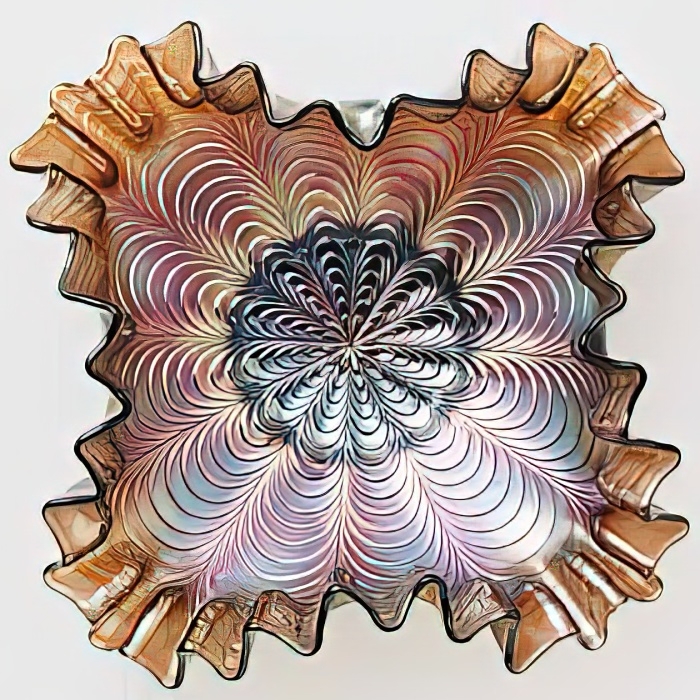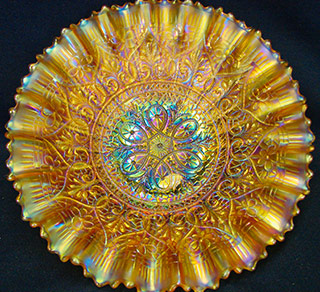(This article was printed in the August 1999 HOACGA newsletter, reprinted with permission)

Rose M. Presznick in her 1965 book “Carnival & Iridescent Glass price guide book 1” called the pattern Flowering Almond. She states in her book on page 35, “the Flowering Almond” was one of the “Gay 90’s” flowers, dainty, ruffly & beautiful. At that time she believed that it was produced by Imperial.
Marion T. Hartung in her 1968 “First Book of Carnival Glass One Hundred Patterns” gave us the name “Peacock Tail” which we now use today. At that time she also thought it to be made by Imperial.
Today we know that it was made by Fenton. The Peacock Tail pattern must have been a very popular pattern when first introduced in 1910 because it is found in seven different shapes: bowls of all sizes with different edges, plates in both 6” and 9”, compotes, bon bons both stemmed and collar based, card trays, hats and tri-cornered (plates/sauces).
The pattern, Peacock Tail, is a simple pattern consisting of 8 to 12 tails with 10 to 21 feathers in each tail. The back pattern is Wide Panel. Bases may be plain or contain a 30 point star. I asked Mr. Frank Fenton about the different bases and he said that probably the plain base came first and then in the later production they put the star in the base to make it more attractive. Base sizes vary from 2 1/16” on some of the hats to 3 7/8” on the larger bowls.
Bowl collectors enjoy having a wide variety of bowls to include in their collections. The bowls vary in size from small 5 3/8” berry bowls with smooth or ruffled edges to large 10” bowls. Colors that I have seen bowls in are marigold, amethyst, blue, green, Vaseline, clambroth, and red. Vaseline and red being the rarest.
I would have to say probably the rarest bowl shape is SQUARE. I have an amethyst one with a 3 ¼” plain collar base, 9” in width, with a tightly crimped edge. The pattern consists of 12 tails with 20 feathers in each tail. Colors I have seen are amethyst, green and marigold. Square is a fantastic shape for this pattern, if you have a square bowl in your collection you are very lucky.
Edge collectors can find ruffled smooth, ruffled saw-toothed, PCE, 3-in-1, tightly crimped CRE, and round. I found the most interesting edge on some of the round bowls and on the bon bons. Some of these pieces contained 12 ruffles, each with 5 points. Some had been smoothed out but you could still see that they had started out as saw-toothed edges.
Plate collectors also can have the Peacock Tail pattern represented in their collections. The plates in both 9” and 6” sizes are highly sought after. This raises the prices on this shape. The 9” plates only have been found in marigold. I know of seven of them at this time. Recently one sold at an Ayers auction for $3300. The plate that I have has a 3 ¼” plain, collar base, 1 5/8” in height, with the pattern consisting of 12 tails each with 20 feathers in each tail.
I have small plates in both blue and marigold. They are 6 3/8” to 6 ½” on a 2 ½” flat collared 30 point starred base. The height is 1” and the pattern has 12 tails each with 10 feathers in each tail. I have also seen the small plate in green. Many of the blue plates have a silvery iridescence and are prettier on the back than on the front. Ones with good color on the front and back have sold for $1000 to $1100 recently.
A shape that must have been quite popular was the tri-cornered (plate/sauce?). The colors I have seen are amethyst, green, marigold and the very rare GREEN OPAL. I know of three in Green Opal. They measure 6” to 6 ½”, have a 2 ½” flat, collared 30 point starred base and are between 1 5/8” to 2 ¼” in height depending on how high the three corners are bent upwards. The pattern has 12 tails with 10 feathers in each tail. I think this is a neat shape for whimsey collectors.
Compote collectors also can have the Peacock Tail pattern in their collections. The compotes I have seen have 6 ruffles with smooth edges. They range in height from 4 5/8” to 4 7/8” depending on if the ruffles are flattened out or not. The width ranges from 6” to 6 ½” across. They have a 3” round base with 8 scallops. The pattern has 10 tails with 20 feathers in each tail. Colors I have seen are amethyst, blue, green and marigold.
Bon bon collectors can have the Peacock Tail pattern represented in their collections. Bon bons are found in collar bases or stemmed. The ones I have seen have four sides up with two handles. The collar bases ones have 12 tails with 18 feathers in each tail. The stemmed ones I have contain 12 tails with 17 feathers in each tail. All the bon bons I have, have 12 ruffles, each with 5 points. The bases on the stemmed bon bons are 3” and are octagon (8 sided) shaped. Colors I have seen are amethyst, green and marigold.
Another shape was the Card Tray. I have it in green, blue and amethyst. They have two sides up and two handles and are lower than regular bon bons. The Card Trays have 12 ruffles each with 5 points and consist of a pattern containing 12 tails with 18 feathers in each tail. A card tray was used to collect calling cards form those people who visited you. They would leave a card with their name and address.
The final shape I have seen Peacock Tail in is the Hat shape. They can be either 4 or 6 ruffled and have smooth edges. They may have either a round or octagon (8 sides) base. All the hats I have contain 8 tails with the round based pieces containing 16 feathers in each tail and the octagon based hats containing 17 feathers in each tail. Colors I have seen in the hat shape are blue, amethyst, green and marigold with I believe marigold being the hardest to find.
Advertising collectors will need to add Peacock Tail items to their collections also. I have seen advertising on the green hats and the green 7” bowls.
Personally I enjoy the pattern and think it is very well done. A very pretty collection can be acquired without spending a lot of money. But if a person wants to seriously collect the pattern then they will have to open up their pocketbooks for the plates, square bowl, red bowl, and the tri-cornered green opal sauce. I believe that this pattern is very underrated. So think about adding a pretty piece in the inexpensive pattern “Peacock Tail” to your collection.
If you have any of the rarer pieces in this pattern I would enjoy hearing from you. Happy Carnival Glass hunting to all of you.

